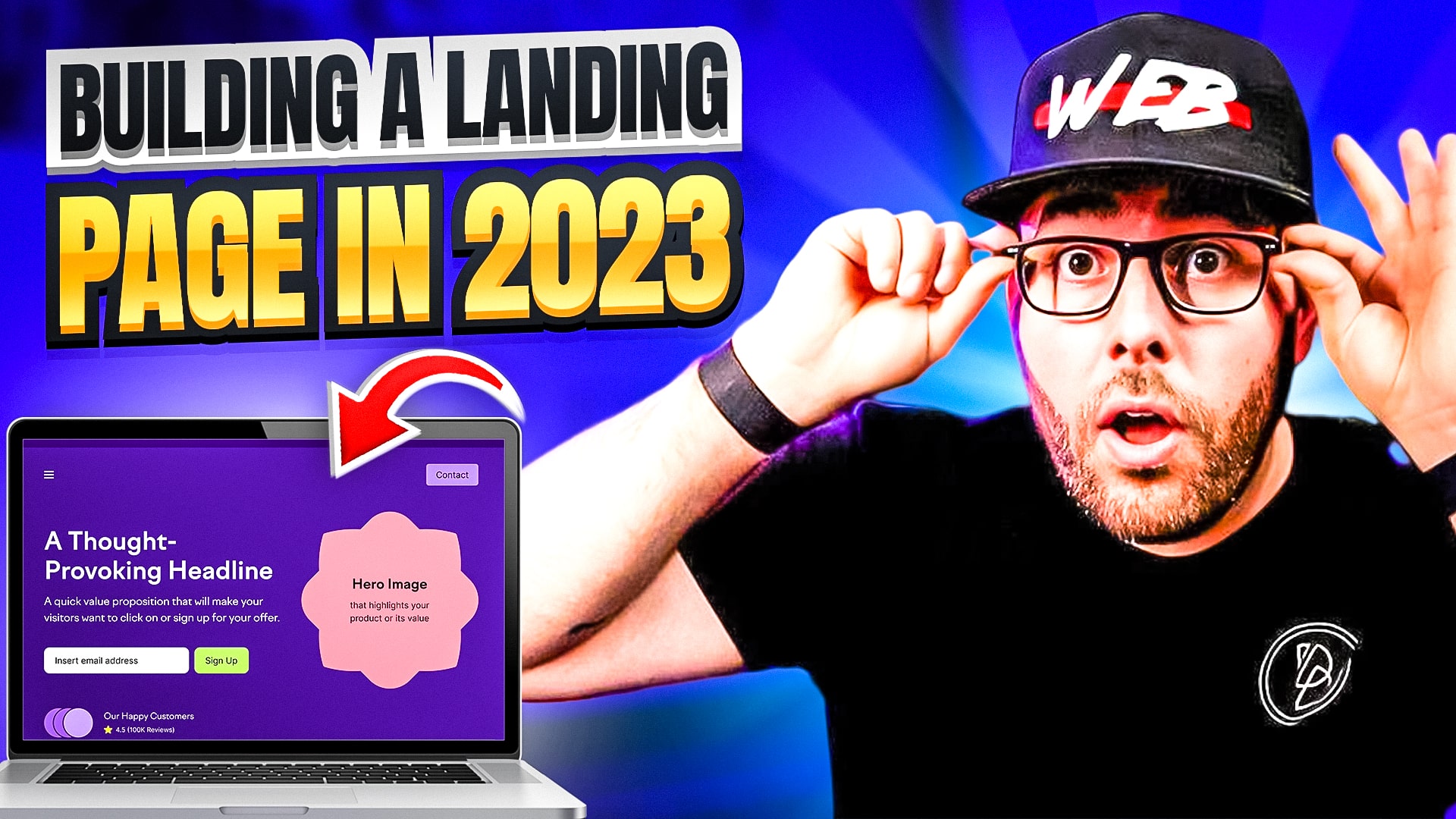
A landing page is a crucial part of your sales funnel and is meant to boost conversion rates. When designed well, it can build trust. Otherwise, it may just waste your money and resources.
If you want to know what elements are necessary to build a landing page that converts and delivers results, read on.
What Is a Landing Page?
A landing page is a dedicated web page created with the objective of converting site visitors into leads or customers as part of a marketing or advertising campaign.
Its focus is on inspiring a specific action, like making a purchase or registering for a newsletter, rather than presenting general information about a company or product.
To achieve this goal, a landing page typically features a clear and persuasive call-to-action, along with a form for visitors to complete in exchange for an offer.
Why Do You Need a Landing Page?
You might think a homepage or about page would suffice to ask visitors for their contact information.
However, a landing page focuses the visitor’s attention by removing any distractions, such as navigation, external links, and unrelated options. This way, you can guide a visitor toward the desired outcome like filling out a lead form. Landing pages are specifically created to drive conversions.
To ensure your landing pages are optimized for conversion, it’s important to follow a few best practices. Let’s dive into the specifics so you can maximize the effectiveness of your landing pages.
Landing Page Best Practices
1. Craft a benefit-focused headline
Since a headline is the first thing a visitor will see and read, it’s important that you craft a strong one.
A weak or vague headline may cause visitors to lose interest and quickly leave the page, which can increase your bounce rate. In fact, seven out of every ten visitors to your landing page will leave right away.
To reduce this bounce rate, it’s crucial that your visitors understand the value of your page and its offerings within seconds of clicking on your link.
So when you are building a landing page, ensure that your headline is clear, concise, and effectively communicates your benefits so that visitors are interested to learn more.
2. Add an enticing subheadline
Equally important to the success of your landing page is the subheadline. It adds detail and context to the headline and makes it more appealing to visitors. Together with the headline, the subheadline should form a compelling value proposition.
Essentially, the subheadline reassures visitors that they are on the right page and that the landing page is relevant to their needs. A well-written subheadline can sustain the reader’s interest and encourage them to continue reading.
3. Choose an image or video that Illustrates the offer
Choosing the right image will help bring your landing page to life. It’s should directly target your audience and give them a sneak peek of the emotions they’ll experience once they take advantage of your offer.
But, how do you know which image will resonate best with your audience? Simply use your marketing skills and conduct split tests to find out which image appeals to visitors the most.
4. Write compelling copy that highlights the benefits, not the features
A strong headline and engaging subheadline has to be followed by compelling, exciting and persuasive copy. Otherwise, you disappoint your visitors and won’t sell your call-to-action.
Make sure your copy is succinct and clearly explains your offer and how they can get it. Focus on the benefits of your offer, so they know what they get out of clicking on your CTA. To inspire visitors to complete the action you want them to take, always speak to them directly by using “you.”
Here are a few tips to make your copy compelling to readers:
- Keep the copy short and above the fold so visitors don’t have to scroll down to see it
- Structure your copy into paragraphs and/or bullet points where applicable. This makes it easier to scan the content.
- Draw visitors’ attention to your CTA by using directional cues like graphics
5. Add a clear call to action that stands out
The call-to-action (CTA) is a critical component to the success of your website landing page, as it can play a significant role in converting visitors into customers.
To ensure the CTA is effective, it’s important to make it stand out visually and clearly communicate the desired action.
One way to do this is by using a contrasting color for the CTA button that stands out from other elements on the page.
Make sure that the language in your CTA is action-oriented by using strong verbs such as “submit,” “download,” or “get it now.” Avoid generic phrases such as “click here” or “submit.”
The placement of the CTA button is also important. It should be kept above the fold and preferably located right next to the copy, which makes it easy to spot. Reiterating the offer in the CTA can also help encourage visitors to take action. Additionally, adding a subtext to the button with additional relevant information can provide further context and entice visitors to act.
In summary, making the CTA stand out through color, language, placement, and relevant subtext can help increase the likelihood of conversions.
6. Include customer testimonials and trust indicators
Building credibility is essential for attracting and retaining customers. One way to strengthen your credibility is thorugh testimonials, social proof, reviews, and badges which enhance visitors’ confidence in your business.
Since trust plays a significant role in converting visitors into customers, incorporating proof elements and trust symbols can help guarantee your legitimacy and increase the likelihood of conversion.
One key rule to building trust is to include a privacy policy, as visitors won’t convert if they feel their information isn’t secure.
Here’s a quick overview of how to build your credibility:
- Use testimonials from real people who match your target audience.
- Include a privacy disclaimer before the submission form field or under the call-to-action button.
- If possible, offer a money-back guarantee to give visitors extra reassurance.
7. Add a simple form to collect information or book a call
Forms play a crucial role in transforming leads into customers by collecting their information. Make sure to keep them straightforward and uncomplicated and avoid overwhelming your visitors with excessive information.
The goal is to create forms that are simple, easy to fill out, and collect only the necessary information to advance the customer journey. A few things to keep in mind:
- The fewer forms you have, the better. Unless you want visitors to take multiple actions (e.g. register for an event and sign up for a newsletter), all you really need is one form per landing page.
- Don’t ask for too much information and stick to only a few fields for visitors to fill out – you only need their name and email.
- Single-column layouts perform best. They are easy to understand and appear less intimidating.
8. Impressive Visuals
The best landing pages have strong visuals. That’s because people are generally more receptive to visual information like images and vidoes than to text. Images, in particular, can create an initial impact even before the visitor reads your content.
Meanwhile, videos can present your story in an intriguing manner and encourage visitors to consider your offer. Keep in mind that your visuals should always be relevant, aligned with your content and offer, and of top-notch quality.
9. Perfect Grammar and Simple Wording
Grammar and word choice are also important for converting leads.
Typos and poor grammar can cause confusion and even lead to a misinterpretation of the offer. This not only looks unprofessional but can also make potential customers hesitant to provide their information.
To ensure clarity and professionalism when you create a landing page, use easy-to-understand language and carefully review your content multiple times before publishing.
By using proper grammar and simple wording, you increase the chances of effectively communicating your offer and building trust with your audience.
10. Testing
Lastly, you should test your landing page to find out whether you need to optimize any parts.
Testing can reveal the impact of various elements on your page, such as the headline, call-to-action placement, language, visuals, benefits, and form fields.
For example, you might discover that a video you included doesn’t appeal to visitors. Taking that video down before publishing your landing page can improve your conversion rate.
Regardless of what you think will or won’t work, you should be open-minded and stick to the data to optimize your landing page. Put simply, use your test results to make data-driven decisions.
Final Thoughts
While there are several ways to build a landing page, our best practices ensure that yours is engaging and effective.
Make sure that visitors understand what you offer right away – this not only improves the user experience, but also builds trust.
Ultimately, a strong landing page will improve your conversion rate as it drives visitors to take action through your CTA.
